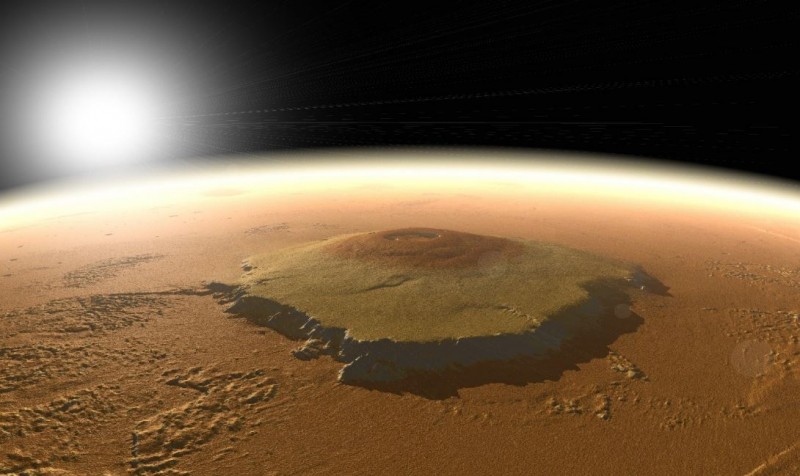
Mars, the red planet, has fascinated humanity for centuries. Among its many remarkable features, one stands out as the tallest volcano in the solar system - Olympus Mons. This colossal geological wonder is three times the height of Mount Everest, Earth's highest peak. In this article, we will delve into the awe-inspiring details of Olympus Mons, exploring its size, structure, scientific significance, and impact on the Martian environment.
Understanding Olympus Mons
2.1 The Discovery of Olympus Mons
Olympus Mons was first identified in the 19th century through telescopic observations. Giovanni Schiaparelli, an Italian astronomer, recorded its existence during the opposition of Mars in 1877. However, it was not until space missions in the latter half of the 20th century that its true nature and grandeur were revealed.
2.2 Geological Features
Olympus Mons is a shield volcano, characterized by its low-profile, broad shape resembling a warrior's shield. Unlike the steep, conical volcanoes on Earth, such as Mount Fuji, shield volcanoes have gentle slopes formed by the eruption of low-viscosity lava. This lava spreads out over large areas, creating the vast, flat summit that distinguishes Olympus Mons.
Size and Height Comparison
3.1 Olympus Mons vs. Mount Everest
The size of Olympus Mons is truly mind-boggling. Standing at an astonishing height of approximately 21.9 kilometers (13.6 miles), it towers over Mount Everest's peak, which reaches a mere 8.8 kilometers (5.5 miles). This makes Olympus Mons more than two and a half times taller than the highest point on Earth.
3.2 Other Impressive Volcanoes
While Olympus Mons is the largest, it is not the only volcanic giant on Mars. The planet hosts other notable volcanoes, such as Arsia Mons, Pavonis Mons, and Ascraeus Mons. Although they are impressive in their own right, none come close to the grandeur of Olympus Mons.
Formation and Structure
4.1 The Volcanic Activity on Mars
Mars' volcanic activity is quite different from what we observe on Earth. While the latter has plate tectonics that lead to diverse volcanic landscapes, Mars lacks active plate boundaries. Instead, its volcanism is concentrated in specific hotspots, like the one responsible for Olympus Mons.
4.2 The Shield Volcano Formation
Olympus Mons was formed through repeated eruptions of basaltic lava over millions of years. The low viscosity of the lava allowed it to flow great distances before cooling and solidifying. As a result, the volcano's slopes are gentle, extending outward for hundreds of kilometers from its center.
The Mysteries of Olympus Mons
5.1 Water on Mars
One intriguing aspect of Olympus Mons is the possibility of past water-related activity on Mars. Scientists have found evidence of ancient river valleys and lakes near the volcano. The relationship between these water features and the volcanic activity on Olympus Mons remains a subject of ongoing research.
5.2 Potential for Future Exploration
Olympus Mons offers a captivating prospect for future Martian exploration. Its massive size and unique geological features could provide valuable insights into the planet's history and potential habitability. Exploring its slopes and surroundings may hold the key to unlocking the mysteries of Mars.
Impact on Martian Climate
6.1 Atmosphere and Weather Patterns
The presence of Olympus Mons plays a crucial role in shaping Mars' climate and atmosphere. Volcanic eruptions release gases and dust into the atmosphere, affecting weather patterns and potentially contributing to the planet's thin, carbon dioxide-rich atmosphere.
6.2 Influence on Dust Storms
Mars is known for its colossal dust storms that can engulf the entire planet. The towering presence of Olympus Mons can influence these storms, creating localized weather patterns and affecting their intensity and duration.
Scientific Significance
7.1 Insights into Planetary Evolution
The study of Olympus Mons provides scientists with valuable information about the geological processes that shaped Mars over billions of years. By understanding the planet's volcanic history, researchers gain insights into the evolution of rocky planets in our solar system.
7.2 Clues to Past Life on Mars
Ancient volcanic regions like Olympus Mons might hold evidence of past microbial life on Mars. Studying the volcano's rocks and minerals could shed light on the planet's potential for harboring life in its distant past.
Olympus Mons in Popular Culture
8.1 Mars in Science Fiction
The colossal volcano has captured the imagination of writers and filmmakers alike. Countless science fiction works have featured Olympus Mons as a backdrop for thrilling adventures set on the Red Planet.
8.2 References in Movies and Literature
From classic novels to modern blockbusters, references to Olympus Mons can be found throughout popular culture, further solidifying its status as an iconic feature of Mars.
In conclusion, Olympus Mons stands as a testament to the breathtaking wonders that await exploration beyond our home planet. Its extraordinary size, unique geological features, and potential scientific significance make it a focal point for future missions to Mars. As humanity continues its quest to unravel the mysteries of the cosmos, the majestic Olympus Mons will undoubtedly play a prominent role in our understanding of the solar system's fascinating celestial bodies.
Cutting-Edge Innovations: How Technology is Reshaping the Way We Travel
Unveiling Hyundai's Latest Marvels
5G Network to be the most Effective Connectivity for the Users